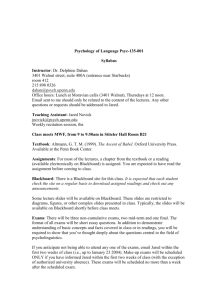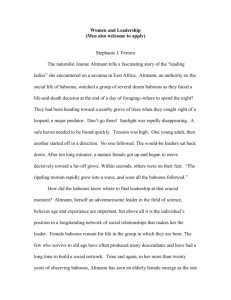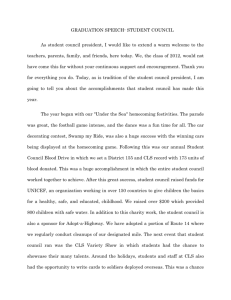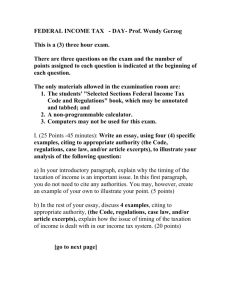The German-American Experience: the Altmann Family Tamara K. Richardson
advertisement
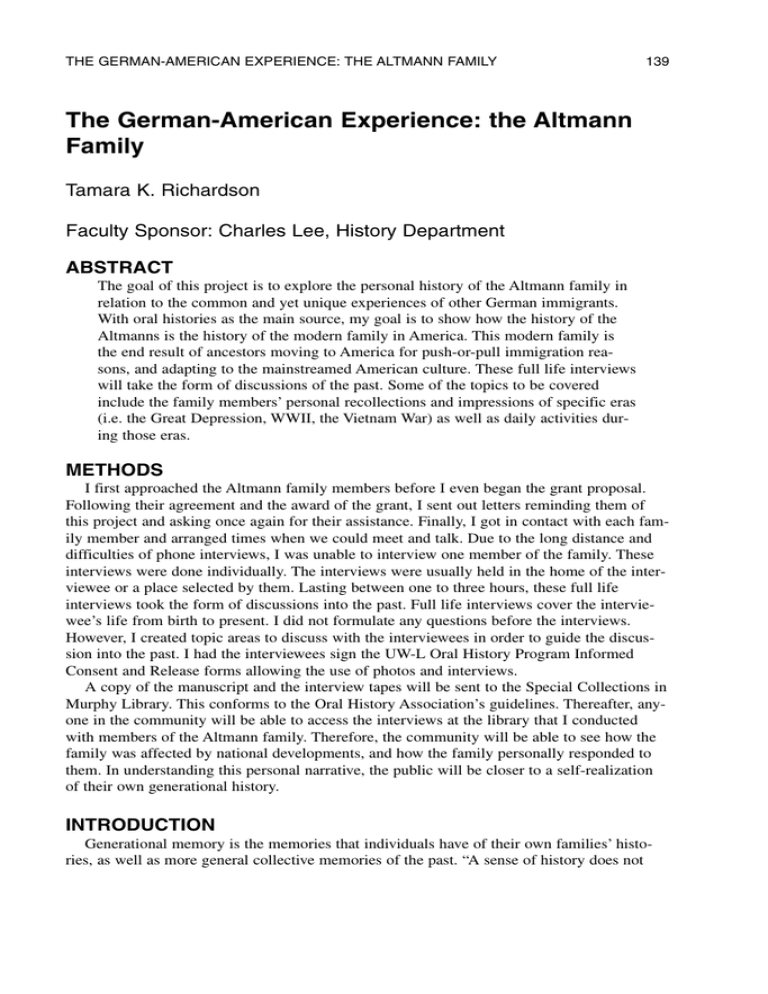
THE GERMAN-AMERICAN EXPERIENCE: THE ALTMANN FAMILY 139 The German-American Experience: the Altmann Family Tamara K. Richardson Faculty Sponsor: Charles Lee, History Department ABSTRACT The goal of this project is to explore the personal history of the Altmann family in relation to the common and yet unique experiences of other German immigrants. With oral histories as the main source, my goal is to show how the history of the Altmanns is the history of the modern family in America. This modern family is the end result of ancestors moving to America for push-or-pull immigration reasons, and adapting to the mainstreamed American culture. These full life interviews will take the form of discussions of the past. Some of the topics to be covered include the family members’ personal recollections and impressions of specific eras (i.e. the Great Depression, WWII, the Vietnam War) as well as daily activities during those eras. METHODS I first approached the Altmann family members before I even began the grant proposal. Following their agreement and the award of the grant, I sent out letters reminding them of this project and asking once again for their assistance. Finally, I got in contact with each family member and arranged times when we could meet and talk. Due to the long distance and difficulties of phone interviews, I was unable to interview one member of the family. These interviews were done individually. The interviews were usually held in the home of the interviewee or a place selected by them. Lasting between one to three hours, these full life interviews took the form of discussions into the past. Full life interviews cover the interviewee’s life from birth to present. I did not formulate any questions before the interviews. However, I created topic areas to discuss with the interviewees in order to guide the discussion into the past. I had the interviewees sign the UW-L Oral History Program Informed Consent and Release forms allowing the use of photos and interviews. A copy of the manuscript and the interview tapes will be sent to the Special Collections in Murphy Library. This conforms to the Oral History Association’s guidelines. Thereafter, anyone in the community will be able to access the interviews at the library that I conducted with members of the Altmann family. Therefore, the community will be able to see how the family was affected by national developments, and how the family personally responded to them. In understanding this personal narrative, the public will be closer to a self-realization of their own generational history. INTRODUCTION Generational memory is the memories that individuals have of their own families’ histories, as well as more general collective memories of the past. “A sense of history does not 140 RICHARDSON depend on the depth of generational memory, but identity and consciousness do, because they rest on the linkage of the individual’s life history and family history with specific historical moments.”1 One year ago I proposed to extend the generational memory of the Altmann family. I am related to the Altmann family by way of my mother Kathy. This undergraduate research project began over a year ago. Inspired by my participation in History 320: Public History class at UW-La Crosse, and by the family stories passed around among my maternal family, I applied and received a grant that allowed me to conduct an oral history project of my maternal family—the Altmann Family. The living members of the Altmann family span generations, ranging in age from 51 to 96 years old. The project focused on the family members’ personal recollections and impressions of specific eras (i.e. the Great Depression, WWII, the Vietnam War) as well as daily activities during those eras. These experiences were thematically related to the common and yet unique experiences of German immigrants to the United States of America. The aim of this oral history project is to focus on the two generations of the Altmann family and relate this family experience to larger national developments during the period, as well as more personal daily occurrences. Many Germans immigrated to America at the turn of the century for many similar reasons such as economic opportunities and freedom of choice. I focused on the immigration of my grandparents’ families to Wisconsin, and their subsequent establishment in central Wisconsin against the backdrop of American national events. Then I followed their transformation into an “American” family and the reason for doing so and the paths that guided them to it. These oral interviews show how the family was affected by national developments, and how the family personally responded to them. OVERVIEW Agnes Draxler Altmann, was born in 1906 to the Draxler family who had immigrated to the United States in the 1890s from Eisenstein, Germany. Her family had 11 children, and they lived on a farm in central Wisconsin. The Altmann family immigrated to the Stratford, Wisconsin, area around the same time also from the Eisenstein, Germany, area. People married, had children, and died as they had in Germany. However, the national developments of the United States, such as the immigrations of Germans and WWI and WWII, altered the normal flow of their pastoral life. These incidents are common to German Americans, but each family, such as the Altmanns, have a unique perspective on these developments. Agnes Draxler was married to Jacob Altmann in the midst of the Great Depression, and their children range in age from 51-69. They had 7 children. The 2 boys are named Casper and Billy, and the 5 girls are named Agnes, Rosie, Mary, Elizabeth, and Kathy. Jacob Altmann died in 1983. The following are excerpts outlining the family history as told to me by the family members. Agnes Altmann describes her parents’ travels to America, and their subsequent settlement in Stratford, Wisconsin, where they eventually became farmers. Agnes Altmann2 My parents lived in Germany and . . . my mother used to tell us stories. She worked for a better class people, she called them “better class people”. And my father was a, what you’d call, a cow-herd, you know—herding cows. And then, anyhow, the men all had to be inducted into the army out in Germany—for life, I THE GERMAN-AMERICAN EXPERIENCE: THE ALTMANN FAMILY 141 guess. And I don’t think that agreed with them, so they. . . The most of them sent their wives, you know, and their children—their wives and children, whatever children they had, over to this country so my mother came in the early 1890s. But anyhow, she came with John, the oldest one, and Elizabeth. And those days, I think it took a whole week/month to cross the ocean, and poor Elizabeth was so sick all the way over. It must have been awful—all trip long. And they landed in (America) and went to Wisconsin. How old was Elizabeth? Oh, she was just a baby. I think she was . . . might have been a year or two old. Anyhow, then . . . see, the men always did that, you know. And then after wards, they came. Cuz they couldn’t all come, you know. They were all, what do you call it? When you don’t do service? Draft dodgers? Yes. And then of course, they settled in the little town—they called it Shantytown, you know. Close to Stratford, (Wisconsin), you know. And the men would work in the mill until they could afford a farm and then bought a farm. And then my parents, bought a farm—I think it was in 1901, they bought a farm close to Stratford, and that’s where I lived until I was grown up. Casper Altmann spoke about his grandfather’s early job, as well as family involvement in the sawmill. Continuing the wood working tradition of his uncles, Casper Altmann is a carpenter. Casper Altmann3 I think some of them (the Draxler and Altmann families) were lumberjacks—mostly they were farmers and working in the sawmill. When they settled in Stratford, my mother’s father, I guess worked in the boiler room down at the Connor’s Mill in Stratford. The whole family was kind of involved—the sawmill was the main source of work. As a matter of fact, my uncle, my mother’s brother—Casper Draxler—he supervised the moving of the machinery and the sawmill up to Leona, in the northern part of Wisconsin. He was involved in that type of work, I guess. Supervisor, I guess. Bill Altmann spoke of farm work that occurred in his childhood. Bill Altmann has a deep understanding of the Altmann farm because he took over the farm in the early 1980s. He had previously worked the farm with his father for most of his life. Bill Altmann4 They (my parents) had the horses around ‘til 1947, when they bought that little John Deer. It took over their jobs—hauling the wagon around and whatnot. Did they get rid of the horses right away? Real quick! Dad hated the horses! Why? 142 RICHARDSON He said they were ornery sons of a gun. What did you think—when they got rid of them? Didn’t think much of it at all. Just that there was more room for heifers in the barn, I guess! Did the horses have names? No, I don’t remember any. As I remember, they were just a couple of brown beasts. Don’t even remember where they were in the barn anymore. Did your Dad have to hire some men to help him with the farm? Or did relatives come over to help plant and things? No, he did it himself—well, Grandpa came and helped out for a number of years before he lost his leg and he’d come over and help with things. But like I say for threshing times, and harvesting times, the neighbors all got together and all exchange help, you know. Fill our silos, fill their silos. There usually were five or six in the neighborhood. One had the silo filler, and the other the thresher machine. Rosie Bean spoke of WWII and her personal recollections of it. She was approximately five years old when the memory she spoke of occurred. Rosie Bean5 The thing I remember about the war (WWII) was running outside and seeing planes and running back in so scared because we thought maybe—and I don’t know if we thought it was the Germans or the Japanese. So something must have filtered through about Pearl Harbor. Because we were so afraid that those planes were coming to bomb us that we would run in and maybe Mom would say “Well, it’s all right.” The only third thing I remember about the war is hearing the church bells ring. Now that sounds funny, cuz we lived two and a half miles south of Stratford, but in the still evening air you could hear those bells. And everyone went to church the night they signed you know, the papers. And we went to church. And as I look back, we didn’t have phones, so how did we find out? The only thing I can think of is that maybe the priest had said “well, we’re going to get together at this time when the papers get signed. I don’t know how else all of us would have known unless there was that little farm thing where one farmer went to the other and said “hey, we’re going.” But everyone went to church and prayed and thanked God that the war was over. Do you remember how your parents felt about the war? Not at all. I can remember Dad listening to the radio, but the war did not touch us in any way that I can physically remember. Because we lived on the farm, we had all the meat we wanted—which lots of people didn’t—we had chickens, we had pigs, we had cows, we had eggs, we had a big garden, we had absolutely no family members involved in the war. . . they were all farmers. I don’t think that any of my cousins were even old enough or were in the war. I don’t think that there was a family member that was involved in the war! It was really ironic. And none of the neighbors, because as I said before, the parents were all the same age. The children were all very young. THE GERMAN-AMERICAN EXPERIENCE: THE ALTMANN FAMILY 143 Agnes Koehler spoke of her brush with death as a young woman, when she suffered a brain aneurysm. The family rallied together and used its resources to pay for her medical bills and support her as she recovered. Agnes Koehler6 You know, it’s funny because I think I got sick on the fifteenth of August, one of the saint’s days. And you know, I don’t know how long I was in hospital. I really don’t. I just know that I got the last half of it in Madison cuz they didn’t know if I was going to make it or not. And you know, back then, they didn’t have the technology to operate or take x-rays. There were no x-rays taken then. What were they able to do for you? When I was starting to. . . I don’t know how they determined this, but when I was starting to feel better, I guess . . . my left side, I think, was paralyzed. For a while there, I had no use of my left hand. And then because they had no facilities for that for operating or whatever they were going to do, they (St. Joseph’s Hospital, Marshfield) made arrangements for me to go to Madison. So Dad and Mom took me down to Madison from the hospital! And then it was funny—I was in the hospital, in this big strange hospital. They were going to . . . I think they did a . . . they put dye into my veins here to see you know where the aneurysm was. And they said it had healed over! That it had stopped bleeding. And the thing that I worried about most was getting my head shaved off! That was what bothered me. Did they have any explanation why the aneurysm went away? Mom claimed it was prayers, and said I guess it was! As Agnes Koehler’s story reveals, the Altmann family drew strength from its religious beliefs. Kathy Richardson remembers other demonstrations of this belief. Kathy Richardson7 Did your family grow up Roman Catholic? Yes, we were very old-fashioned strict Catholic Germans. You’ve mentioned in the past about special devotions. Oh, my mother was very, very devoted to the Blessed Virgin. She’s talked many many times praying to her and having her prayers answered. And I think she got a lot of comfort from her cuz she was a fellow woman. One thing that she did was when I was a young child, Mom and Dad bought a very beautiful cement statue and put it up in their yard—back yard. And Dad was very insistent about having a blue spruce planted behind the shrine, and they had cedars around it, and Mom had many many beautiful flowers. It was just very beautiful. And she had the priest come out and bless the shrine. The shrine was so beautiful and so unusual—we had a lot of women stopping by on the farm when I was a child, to see it. CONCLUSION There were three great waves of German immigration. The first occurred roughly between 1845-1855. About 939,000 Germans of all ages came to America at that time. The second occurred between 1865-1875. This time about 1,066,333 Germans immigrated. The last and 144 RICHARDSON greatest influx of German immigrants occurred between 1880-1893. Roughly 1,849,056 Germans settled in America.8 The Altmann and Draxler families came over in the third wave of German immigration. Common experiences that these families shared with other German Americans include the immigration experience, finding work in the New World, farming in the Midwest, both World Wars and other national endeavors, as well as integrating into the national culture. However, due to the small community of common ethnic backgrounds, the development of the Altmann and Draxler families proceeded at different rates. A large percentage of people from Stratford, Wisconsin, came to this country from Germany around the same time. This common ethnic background and age groups allowed the settlers to experience national developments in similar ways to one another. For example, as Rosie Bean stated in her interview “they were all farmers. I don’t think that there was a family member that was involved in the war (WWII)! And none of the neighbors, because as I said before, the parents were all the same age. The children were all very young.”9 Similar responses were revealed about family reactions to WWI, the Great Depression, and the Vietnam War. While it is possible that time has allowed them to gloss over deprivations in their memories, an alternate explanation is also likely—that the age group of the community naturally prevented them from first hand experience in national conflicts, and the farming allowed them to enjoy relative prosperity even during hard times. In conclusion, the Altmann family has shared similar national experiences to that of other German Americans, but in contrast, this family has also enjoyed isolation from some of the worse deprivations and racial misunderstandings common in other parts of the United States. ACKNOWLEDGEMENTS The people I would like to thank for helping me with this project are: —Dr. Charles Lee, History Department —Kathy Richardson, for her unfailing support —Agnes Altmann, Casper Altmann, Agnes Koehler, Rosie Bean, Billy Altmann, Mary Leick, Betty Altmann, and Kathy Richardson for giving so generously of their time and memories —The Undergraduate Research Committee for giving me this opportunity ENDNOTES 1 Hareven, Tamara. “The Search for Generational Memory.” Public History Readings Eds. Phyllis K. Leffler and Joseph Brent. (Malabar, Florida: Krieger Publishing Company, 1992) 270. 2 Altmann, Agnes, grandmother. Personal interview. Stratford, WI, July 17, 2001. 3 Altmann, Casper, uncle. Personal interview. Marshfield, WI, March 20, 2002. 4 Altmann, Billy, uncle. Personal interview. Stratford, WI, July 20, 2001. 5 Bean, Rosie, aunt. Personal interview. Lake Tomahawk, WI, July 26, 2001. 6 Koehler, Agnes, aunt. Personal interview. Marshfield, WI, August 16, 2001. 7 Richardson, Kathy, mother. Personal interview. Marshfield, WI, March 22, 2002. 8 Zeitlin, Richard H. Germans in Wisconsin (Madison, WI: The State Historical Society, 2000) 6-7. 9 Bean, Rosie, aunt. Personal interview. Lake Tomahawk, WI, July 26, 2001.
